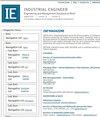Fabrication and Identification of the Efficiency of a Si-Based Solar Cell
引用次数: 0
Abstract
This research represents the fabrication and characterization of a solar cell which is based on a thin p-type silicon (Si) wafer. Solar cells are the basic building blocks of Solar Panels or Modules. There are presently nine companies manufacturing solar modules in the country. Nowadays a large amount of electricity comes from solar cell. The total demand for solar cells in assembling solar modules of the nine companies are about 80-90MWp annually. Mainly, cost of solar cell depends on the Brand, type of crystal structure (Mono or Multi) and the shape or size of wafer. For the first time in the country, ‘Bangladesh Atomic Energy Commission (BAEC)’ has set up a laboratory to fabricate crystalline solar cells on a pilot basis. The method used to fabricate solar cells is the low-cost diffusion technique using POCl 3 gas source. Several solar cells of 150×150 mm 2 sizes and 200 micrometer thick are produced and characterized in the laboratory. A p-type silicon wafer is cleaned and textured to make its surface pyramid shape for absorbing more sunlight. The p-n junction used in Si-based solar cell is created after applying diffusion technique using Phosphorus-oxy-try chloride (POCl 3 ) within the silicon wafer and putting Aluminum (Al) paste on one side of the wafer. Perfectly texturing ensures the excellent pyramid height of the silicon wafers. The pyramid heights of raw, textured and doped wafers are 8233.2 A, 15222.5 A and 55654.1 A respectively. The pyramid surface shows the increasing light absorption by the solar cell that can lead to an increase in conversion efficiency of the device. The efficiency of the produced solar cell is 3.3%. The results have shown that some challenges and good opportunities in getting the high-efficient and cost effective solar cells. If the cost effective technology can be made familiar in Bangladesh then it will help in solving the power crisis in the country a great deal.硅基太阳能电池的制备及效率鉴定
本研究代表了一种基于薄p型硅(Si)晶圆的太阳能电池的制造和特性。太阳能电池是太阳能电池板或组件的基本组成部分。目前国内有9家公司生产太阳能组件。现在大量的电力来自太阳能电池。九家公司在组装太阳能组件时,每年对太阳能电池的总需求约为80-90MWp。太阳能电池的成本主要取决于品牌、晶体结构类型(单晶还是多晶)以及晶圆的形状或尺寸。孟加拉国原子能委员会(BAEC)在该国首次建立了一个实验室,在试点基础上制造晶体太阳能电池。利用POCl 3气源制备太阳能电池的方法是低成本扩散技术。生产了几种尺寸为150×150 mm 2,厚度为200微米的太阳能电池,并在实验室中进行了表征。p型硅片经过清洗和纹理处理,使其表面呈金字塔形,以吸收更多的阳光。硅基太阳能电池中使用的p-n结是在硅片内应用扩散技术,在硅片的一侧涂上铝(Al)浆料制成的。完美的纹理保证了硅片的金字塔高度。原始晶圆、织构晶圆和掺杂晶圆的金字塔高度分别为8233.2 A、15222.5 A和55654.1 A。金字塔表面显示了太阳能电池对光的吸收增加,从而提高了设备的转换效率。所生产的太阳能电池的效率为3.3%。结果表明,在获得高效、低成本的太阳能电池方面存在一些挑战和良好的机遇。如果这种低成本的技术能够在孟加拉国普及,那么它将极大地帮助解决该国的电力危机。
本文章由计算机程序翻译,如有差异,请以英文原文为准。
求助全文
约1分钟内获得全文
求助全文

 求助内容:
求助内容: 应助结果提醒方式:
应助结果提醒方式:


